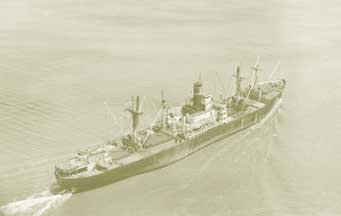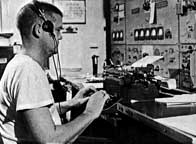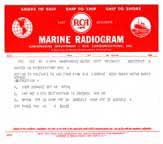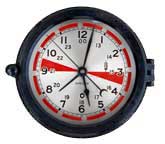
|
| During World War II, marine
radio communications met a severe test. Between 1939 and 1945, the U.S.
Maritime Commission built more than five thousand merchant vessels to
carry the mountains of material required for the war effort. This massive
building program was centered first on the Liberty Ship and then on
the more sophisticated Victory Ship.Each vessel carried a radio and
at least one radio operator.
American industry, led by RCA's Radiomarine Corporation and by Mackay
Radio, produced simple but powerful console-mounted, tube radio systems
that were manufactured by the hundreds. The men and women trained
to operate these sets used only Morse telegraph code. From saving
the lives of torpedoed seamen, to seeing that the ship arrived where
it was needed, the wartime operators "stuck by their keys"
and got the job done.
Above: Many Victory ships, with original radio gear, were used to
transport cargos from the 1940s through the Vietnam War era. Here,
the Towanda Victory returns to San Francisco in the early 1950s.
|
  |
| Radio operators aboard Victory ships
transcribed messages onto a typewriter known as "the mill".
Messages were typed onto Radiograms, like the one shown here, found
on board the Rider Victory. |
 |
RED WEDGES
Two red wedges highlighted the three-minute periods of radio silence
which were observed twice an hour. During these periods, all transmission
was stopped and operators listened for any calls on the International
Distress Frequency.
EXTRA HOUR HAND
Radio clocks were always set to indicate Greenwhich Mean Time (GMT).
The extra hour hand could be set to any time the Radio Officer desired,
usually the time at the ship's home port.
RED BANDS AROUND OUTER EDGE
Red blocks around the edge of the clock dial allowed the operator
to time the series of four-second dashes which he could send on the
distress frequency to trigger the auto-alarms of nearby vessels. This
initial alarm would be followed by an "SOS" sent in standard
Morse, and information on the ship's location and situation.
|
 |
| The wartime 4-U (four-unit) radio, large
and heavy by modern standards, is essentially 1930s technology, simplified
and standardized for mass production.
The Radiomarine 4-U radio system, designed about 1940, includes four
independent receivers and three transmitters, all mounted in a single
console. The components are grouped in four basic units. Ad from the Nautical Gazette, April 1946.
|
|